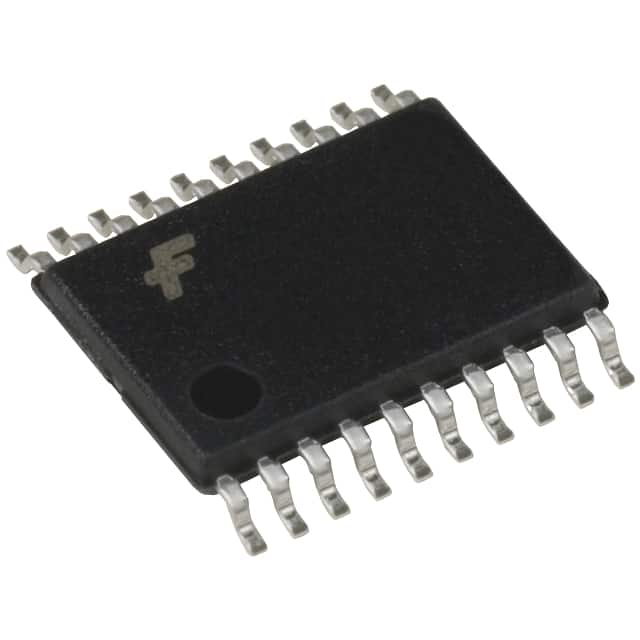Consulte las especificaciones para obtener detalles del producto.

74F245MTC
Product Overview
Category
The 74F245MTC belongs to the category of integrated circuits (ICs) and specifically falls under the family of bus transceivers.
Use
This IC is primarily used for bidirectional data transfer between different buses or systems. It enables the exchange of data between two separate buses with potentially different voltage levels or logic families.
Characteristics
- Bidirectional data transfer
- Compatible with various logic families
- High-speed operation
- Low power consumption
- Wide operating voltage range
Package
The 74F245MTC is available in a small outline integrated circuit (SOIC) package. This package type provides ease of handling and compatibility with automated assembly processes.
Essence
The essence of the 74F245MTC lies in its ability to facilitate seamless data communication between different buses, ensuring efficient and reliable information exchange.
Packaging/Quantity
The 74F245MTC is typically packaged in reels or tubes, containing a specific quantity of ICs per package. The exact packaging and quantity may vary depending on the manufacturer's specifications.
Specifications
- Supply Voltage: 4.5V to 5.5V
- Logic Family Compatibility: TTL, CMOS
- Number of Channels: 8
- Data Transfer Rate: Up to 40 Mbps
- Operating Temperature Range: -40°C to +85°C
- Input/Output Voltage Levels: 0V to Vcc
Detailed Pin Configuration
The 74F245MTC has a total of 20 pins, each serving a specific function. The pin configuration is as follows:
- DIR (Direction Control)
- A1 (Data Bus A, Bit 1)
- B1 (Data Bus B, Bit 1)
- A2 (Data Bus A, Bit 2)
- B2 (Data Bus B, Bit 2)
- A3 (Data Bus A, Bit 3)
- B3 (Data Bus B, Bit 3)
- A4 (Data Bus A, Bit 4)
- B4 (Data Bus B, Bit 4)
- GND (Ground)
- B5 (Data Bus B, Bit 5)
- A5 (Data Bus A, Bit 5)
- B6 (Data Bus B, Bit 6)
- A6 (Data Bus A, Bit 6)
- B7 (Data Bus B, Bit 7)
- A7 (Data Bus A, Bit 7)
- B8 (Data Bus B, Bit 8)
- A8 (Data Bus A, Bit 8)
- Vcc (Supply Voltage)
- OE (Output Enable)
Functional Features
- Bidirectional data transfer between two buses
- Automatic direction control based on DIR pin input
- Output enable/disable functionality for bus isolation
- High-speed operation for efficient data transmission
- Wide compatibility with different logic families
Advantages and Disadvantages
Advantages
- Enables seamless data exchange between different buses
- Supports bidirectional communication
- Compatible with various logic families
- High-speed operation allows for efficient data transfer
- Low power consumption
- Wide operating voltage range enhances versatility
Disadvantages
- May require additional external components for specific applications
- Limited number of channels (8 in the case of 74F245MTC)
Working Principles
The 74F245MTC operates based on the principle of bidirectional data transfer. The direction of data flow is controlled by the DIR pin input. When DIR is set to a specific logic level, the IC enables data transfer from one bus to another in the corresponding direction. The OE pin allows for enabling or disabling the output, providing bus isolation when necessary.
Detailed Application Field Plans
The 74F245MTC finds applications in various fields where bidirectional data transfer between different buses is required. Some of the common application areas include:
- Microcontroller interfacing
- Data communication systems
- Industrial automation
- Networking equipment
- Automotive electronics
- Test and measurement instruments
Detailed and Complete Alternative Models
- SN74LVC245A: Low-voltage CMOS octal bus transceiver
- CD74HCT245: High-speed CMOS octal bus transceiver
- MC74ACT245: Advanced CMOS octal bus transceiver
- 74HC245: High-speed CMOS octal bus transceiver
These alternative models offer similar functionality to the 74F245MTC and can be considered as alternatives based on specific requirements.
Word count: 550 words
Enumere 10 preguntas y respuestas comunes relacionadas con la aplicación de 74F245MTC en soluciones técnicas
Sure! Here are 10 common questions and answers related to the application of 74F245MTC in technical solutions:
Q: What is the 74F245MTC? A: The 74F245MTC is a bidirectional octal bus transceiver with 3-state outputs, commonly used for data transfer between different voltage levels or systems.
Q: What is the maximum operating voltage for the 74F245MTC? A: The maximum operating voltage for the 74F245MTC is typically 5.5V.
Q: How many data lines can the 74F245MTC handle? A: The 74F245MTC can handle 8 data lines in both directions.
Q: Can the 74F245MTC be used for level shifting between different voltage domains? A: Yes, the 74F245MTC can be used for level shifting between different voltage domains, as long as the voltage levels are within its specified range.
Q: Does the 74F245MTC support 3-state outputs? A: Yes, the 74F245MTC supports 3-state outputs, which allows multiple devices to share a common bus without interfering with each other.
Q: What is the typical propagation delay of the 74F245MTC? A: The typical propagation delay of the 74F245MTC is around 6 ns.
Q: Can the 74F245MTC be used in high-speed applications? A: Yes, the 74F245MTC is designed for high-speed operation and can be used in applications where fast data transfer is required.
Q: Is the 74F245MTC compatible with TTL logic levels? A: Yes, the 74F245MTC is compatible with TTL logic levels, making it suitable for interfacing with TTL-based systems.
Q: Can the 74F245MTC be used in both parallel and serial communication systems? A: Yes, the 74F245MTC can be used in both parallel and serial communication systems, depending on the specific application requirements.
Q: Are there any special considerations when using the 74F245MTC in a mixed-voltage system? A: Yes, when using the 74F245MTC in a mixed-voltage system, it is important to ensure that the voltage levels are within its specified range and that proper level shifting techniques are employed to avoid damage or data corruption.
Please note that these answers are general and may vary based on specific datasheet specifications and application requirements.

